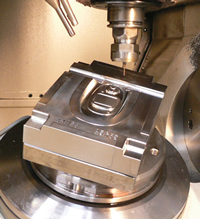Resources
CAD and CAM: Integrated or Optimized
How to decide between integrated CAD and CAM or an optimized, stand-alone program for each department.
Recent years have seen a number of articles on the benefits of closer integration of CAD and CAM. Of course, integrated CAD/CAM systems from a single company have been available since 1972. The new trend is for the integration of CAM systems into CAD software from a completely different developer. The decision for moldmakers is to choose between integrated CAD and CAM or an optimized, stand-alone program for each department.
A Closer Look at Integration
The closer integration of the two technologies offers obvious advantages to smaller manufacturers of simpler parts, where the product designer will often also be the machine tool programmer. Having a common interface for the CAD and CAM software makes learning the two programs easier, while automatic updating of the toolpaths if the design changes will probably give the correct results.

More complex five-axis machines require specialist programming skills. Image courtesy of Delcam.
However, the benefits are less clear for larger moldmaking companies, especially those making bigger or more complex tools, and those using more advanced high-speed or five-axis machine tools. In these organizations, the mold designer and the machinist are likely to be different people working in different parts of the company.
Typically, one will be working in a design office, while the other will be in an office next to the shop floor or even on the shop floor. Both will have developed a high level of skill in their respective areas of expertise and in the software that they use. Improved data translation systems mean that there is now much less likelihood of information being incorrect when transferred between the different programs.
Most importantly, the more complex the mold becomes, the less likely it is that automated toolpath generation will produce the most efficient machining routines or the best surface finish in the final tool. Updating toolpaths automatically will almost certainly give the correct result for simple alterations—for example, changing the drilling routine after moving the position of a hole in a mold plate. With more sophisticated changes to a complex core or cavity, the optimum result is much less certain to be achieved. This is especially true when using more sophisticated machine tools.
Separating Design and Manufacture
It is somewhat ironic that software companies are promoting closer integration when an increasing number of toolmakers are separating design and manufacture by putting responsibility for CAM onto the shop floor. This approach gives a number of potential advantages.
First, shop floor operators generally know more about any quirks of the machines within their company. They should, therefore, be better able to select the optimum machining strategy, tool type and size, feedrates, stepover and stepdown, etc. for each job, taking full account of any limitations of the machine on which it will be run. This gives more efficient use of the CNC machines and also should ensure higher quality machining.
The shop floor personnel also will be more aware of new machining technology. Improvements in cutting tools are of particular importance since modern tooling allows the use of speeds and feeds that would have been impossible even five years ago. Failing to take advantage of these faster options could mean that significant opportunities to increase productivity are being missed.
Just as important, the machine operators will be more aware of conditions on the shop floor, in particular the tooling, materials, machines and accessories such as clamps, that are currently available. This will help to improve job scheduling and reduce downtime.
Similarly, the machine operator is able to make any changes to the program that might become necessary on the spot. For example, if the tool selected for the job is already being used, or becomes worn and cannot be replaced, the machine operator will be able to generate a replacement program for the nearest alternative tool size relatively quickly. The time saved will increase machine utilization.
The mold designers also will benefit because removing CAM programming from their workload will leave more time for design work and quoting new business. The latter factor is becoming especially important. The need for faster product development means that customers are not prepared to wait as long for quotes.
Summary
As with all technical developments, it is important that companies do not regard integrated CAM inside a CAD system as a panacea to solve all of their problems. There are definite benefits for smaller companies making simple tools, but the advantages for larger moldmakers are much less clear cut. These companies may be better served by giving their specialist designers and machinists the best software for their jobs, rather than adopting an integrated solution.
- What affects injection mold machining accuracy and productivity?
- Shenzhen top five mold manufacturers: how plastic products are processed and produced?
- Shenzhen Ideal Vowin mold manufacturer: how to effectively improve the precision of mold processing?
- Chrome plating, a process that makes cars stylish
- Six injection molding processing technologies for home appliance plastic products
- Advantages and disadvantages of injection molding vs blow molding
- What is automotive hot stamping and molding technology?
- What is the difference between a hot runner and a cold runner in the mold?
- Automotive stamping die in large, precision and other areas of progress is obvious, the rapid development of plastic and rubber molds
- The top ten problems that are likely to occur in the mold testing process














